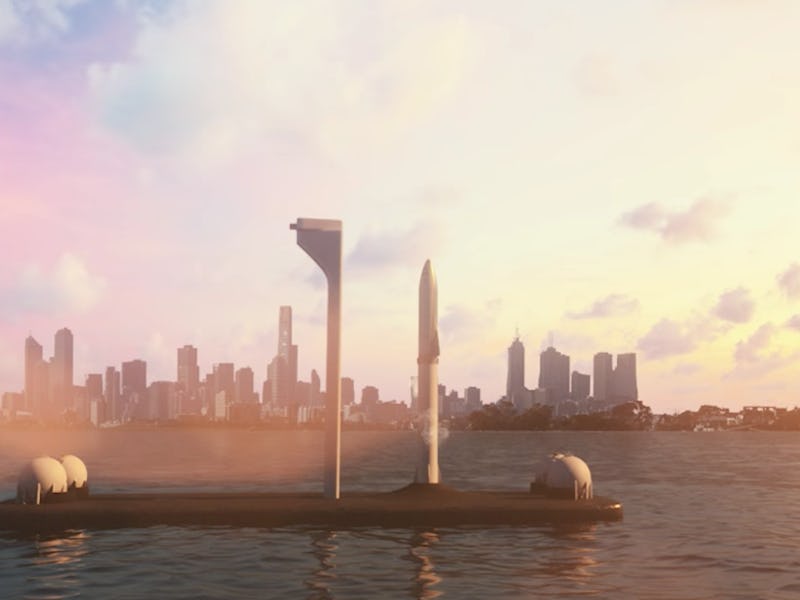SpaceX vs. Blue Origin: Elon Musk responds to Starship size comparison
SpaceX CEO Elon Musk weighed in on a fan-made image that showed the inside of the Starship compared to other rockets like the New Glenn.

How big will the SpaceX Starship internal cabin be? Thanks to a new illustration, we have a slightly clearer idea.
A size comparison shared on Twitter Friday has caught the attention of SpaceX CEO Elon Musk. The image, produced by Georgia Tech industrial designer Ken Kirtland IV, shows six rocket fairings with a person inside to demonstrate their sheer scale. The image shows a United Launch Alliance Vulcan fairing in both standard and extended variants, a Blue Origin New Glenn fairing, and three SpaceX fairings. The SpaceX fairings cover the current Falcon 9 and Falcon Heavy fairing, an extended variant for the Falcon Heavy, and the nosecone used on the upcoming Starship.
Responding to the size comparison, Musk explained:
"Starship fairing will actually have more height than shown here. Dome will be flatter & more of tip is accessible. Usable volume ~1000 cubic meters."
The fairings image up close.
The image helps put into perspective the sheer scale of the project currently being undertaken at SpaceX. The company is developing the Starship at its Boca Chica facility in Texas. The fully-reusable ship stands around 400 feet tall when paired with the Super Heavy booster, and is capable of transporting over 150 tons or 100 people into space at a time. SpaceX plans to use the ship to establish a human city on Mars by 2050.
The ambitious ship requires an ambitious fairing. The company is aiming to offer up to 1,000 cubic meters of volume. That should result in pressurized cabin space of comparable size to an Airbus A380. Musk has explained before his plans to offer cabins for two to three people, using each side of the room more effectively due to the nature of zero gravity.
How does the Starship fairing compare to the other ships?
- The upcoming Vulcan Centaur is set to offer a 5.4-meter diameter (17.7 feet) payload fairing in both 15.5 meters (51 feet) or 21.3 meters (70 feet) height configurations.
- The Falcon user's guide shows the standard fairing measures 5.2 meters (17.2 feet) in outer diameter and 13.2 meters (43.5 feet) high. The internal payload area has a maximum diameter of 4.6 meters (15.1 feet) and a maximum height of 11 meters (36.1 feet).
- The Blue Origin payload user's guide claims the upcoming New Glenn fairing measures seven meters (23 feet) wide, 21.9 meters (72 feet) high, and offers an internal usable volume that measures "at least" 450 cubic meters (16,000 cubic feet).
- The Starship user guide shows the payload volume reaches eight meters (26.3 feet) diameter and 17.2 meters (56 feet) high. The guide also claims that an extended variant can reach 22 meters (72 feet) high.
The Starship's guide claims that the standard fairing results "in the largest usable payload volume of any current or in development launcher."
When it launches, it should be impressive. This month, the company launched its "SN5" prototype into the air for the first time. While the ship sported many of the same features as the final ship, it lacked the nosecone expected to debut on future vehicles.
The Inverse analysis – The image highlights just how large the planned Starship fairing will be, even compared to other future ships like the ULA Vulcan Centaur or the Blue Origin New Glenn.
The key will be whether SpaceX can deliver on its ambitious promises: Musk has outlined a bold timetable that suggests the first cargo-filled Starships could launch for Mars in 2022. The Starship is impressive in and of itself, but Musk's plans for its future missions mean it may not end up as the most impressive aspect of the ship.
Update 08/17 12:30 p.m. Eastern time: An earlier version of this story listed the New Glenn's fairing as measuring 17.2 meters tall. It has since been corrected.
This article was originally published on